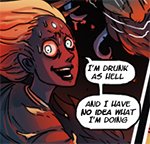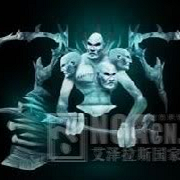|
Welcome goonlings to the Awful Book of the Month! In this thread, we choose one work of Resources: Project Gutenberg - http://www.gutenberg.org - A database of over 17000 books available online. If you can suggest books from here, that'd be the best. SparkNotes - http://www.sparknotes.com/ - A very helpful Cliffnotes-esque site, but much better, in my opinion. If you happen to come in late and need to catch-up, you can get great character/chapter/plot summaries here.  For recommendations on future material, suggestions on how to improve the club, or just a general rant, feel free to PM the moderation team. For recommendations on future material, suggestions on how to improve the club, or just a general rant, feel free to PM the moderation team.  Past Books of the Month [for BOTM before 2018, refer to archives] 2018 January: Njal's Saga [Author Unknown] February: The Sign of the Four by Arthur Conan Doyle March: Lincoln in the Bardo by George Saunders April: Twenty Days of Turin by Giorgio de Maria May: Lectures on Literature by Vladimir Nabokov June: The Electric Kool-Aid Acid Test by Tom Wolfe July: Warlock by Oakley Hall August: All Creatures Great and Small by James Herriott September: The Magus by John Fowles October: I'll Be Gone in the Dark by Michelle McNamara November: Arcadia by Tom Stoppard December: Christmas Stories by Charles Dickens 2019: January: Roadside Picnic by Arkady and Boris Strugatsky February: BEAR by Marian Engel March: V. by Thomas Pynchon April: The Doorbell Rang by Rex Stout May: Thinking, Fast and Slow by Daniel Kahneman June: 1491: New Revelations of the Americas Before Columbus by Charles C. Mann July: The Art of Fielding by Chad Harbach August: Memoirs of Extraordinary Popular Delusions and the Madness of Crowds by Charles Mackay September: Picnic at Hanging Rock by Joan Lindsay October: Her Body and Other Parties by Carmen Maria Machado November: The Maltese Falcon by Dashiell Hammett December: Moby Dick by Herman Melville 2020: January: The Jungle by Upton Sinclair February: WE by Yevgeny Zamyatin March: The Autobiography of Benvenuto Cellini by Benvenuto Cellini April: The Decameron by Giovanni Boccaccio May: Black Lamb and Grey Falcon by Dame Rebecca West June: The African Queen by C. S. Forester July: The End of Policing by Alex S. Vitale August: The Merry Adventures of Robin Hood, of Great Renown in Nottinghamshire, by Howard Pyle September: Strange Hotel, by Eimear McBride  Current: Kwaidan: Stories and Studies of Strange Things (怪談)("Ghost Stories"), by Lafcadio Hearn Book available here: https://www.gutenberg.org/ebooks/1210 Audiobook: here. About the book quote:Hearn declares in his introduction to the first edition of the book, which he wrote on January 20, 1904, shortly before his death, that most of these stories were translated from old Japanese texts. He also states that one of the stories – Yuki-onna – was told to him by a farmer in Musashi Province, and his was apparently the first record of it, both by his own account and according to the research of modern folklorists. Riki-Baka is based on a personal experience of Hearn's. While he does not declare it in his introduction, Hi-Mawari – among the final narratives in the volume – seems to be a recollection of an experience in his childhood (it is, setting itself apart from almost all the others, written in the first person and set in rural Wales). quote:Hearn, even at his most negligent, was consistent in his transcription; his Japanese tales are stark and do not resemble the fairy tales produced by nineteenth-century writers in Europe. Occasionally, for lack of a transition and for touching a chord in his American readers, he invented elements that were closer to the smoky djinnis of the Thousand and One Nights, or the monsters of Greek myths, but he rarely employed the repetitions familiar to European readers; instead, he translated brief jingles or occasional poems that were traditional in Japanese stories. quote:What makes these stories, preserved from ancient times, especially readable today is the preternaturally postmodern form they are given in Hearn’s deeply idiosyncratic telling. He inserts himself into them in the most casually disruptive ways: offering interpretations or digressive asides about the person who first told him the tale in question, or saying that there is more to the story but he has forgotten it. He interrupts one tale to complain, Charles Kinbote-like, about the ubiquitous sight of telegraph poles in the hotel where he was staying when he first heard the story he is relating. Elsewhere, he lets us know that he is drawing from someone else’s book (an Englishman’s “Japanese Fairy-Tale Series”)—relaying the story “in my own words,” Hearn assures us, but with the book open beside him as he writes. At the end of “The Corpse-Rider,” he complains that he does not find its conclusion “morally satisfying.” Metafiction goes back hundreds of years before Hearn, but meta-folk feels like an offshoot that one has not previously encountered. As so often with Hearn, there are two ways to feel about this. Unquestionably, it makes for a more interesting and sophisticated reading experience, and yet these authorial intrusions in ancient narratives represent a kind of claim to them, a display of control. https://www.newyorker.com/magazine/2019/09/16/why-lafcadio-hearns-ghost-stories-still-haunt-us About the Author quote:
https://www.theparisreview.org/blog/2019/07/02/the-many-lives-of-lafcadio-hearn/ quote:One hesitates to say that Hearn is now being “rediscovered” by an English-language readership, because his output was so voluminous and so varied that some corner of it seems to resurface every decade or so. His haiku and tanka translations influenced Pound, Rexroth, and others. His “La Cuisine Creole”—the first cookbook of its kind—is historically invaluable. There are Hearn museums virtually everywhere he lived in Japan, and in 2015 the Lafcadio Hearn Japanese Gardens were dedicated, in the seaside town of Tramore, Ireland, near the spot where young Hearn said goodbye to his father for the last time. https://www.newyorker.com/magazine/2019/09/16/why-lafcadio-hearns-ghost-stories-still-haunt-us quote:Koizumi Yakumo (小泉 八雲, 27 June 1850 – 26 September 1904), born Patrick Lafcadio Hearn (/hɜːrn/; Greek: Πατρίκιος Λευκάδιος Χερν), was a Japanese writer of Greek-Irish descent. He is best remembered for his books about Japanese culture, especially his collections of legends and ghost stories, such as Kwaidan: Stories and Studies of Strange Things. In the United States, he is also known for his writings about New Orleans, based on his decade-long stay there. quote:In the late 19th century, Japan was still largely unknown and exotic to Westerners. However, with the introduction of Japanese aesthetics, particularly at the Paris Exposition Universelle of 1900, Japanese styles became fashionable in Western countries. Consequently, Hearn became known to the world by his writings concerning Japan. In later years, some critics would accuse Hearn of exoticizing Japan, but because he offered the West some of its first descriptions of pre-industrial and Meiji Era Japan, his work is generally regarded as having historical value.[21][22][23] quote:It is odd that he was left out of the surrealist canon by André Breton, who included Hearn’s close kin, Lewis Carroll and Rimbaud. The surrealists did not, most likely, read his work, because it was popular. Obscurity shadows literature, a protective shield that Hearn, who was actually read in his own time, did not possess. Yet, he was obscure in the most fantastic and ghostly way. Like the famous vanishing details of the stolen painting, Hearn was absorbed by the ghost-world and put to work as its mouthpiece. quote:What we make of Hearn now depends on how we frame him in the volatility of our own historical moment. Close one eye and he is a unique tragic hero, a victim and an outcast, who consistently championed nondominant cultures and tried to bind his own deep psychological wounds by celebrating in prose the world beyond the white, European society that had tortured and rejected him. Close the other eye and he is just another nineteenth-century white man who appointed himself an expert on places and cultures in which he was a tourist, making a career out of depicting or interpreting these cultures as if they were his to represent or to profit from. The very premise of Truong’s novel makes a salient contemporary point: Hearn’s global search for love and acceptance may have been touching, but even the search was a privilege. The women in his wake—none of them white—suffered gravely as well, and they didn’t have the option of lighting out for the territories. Pacing  Read as thou wilt is the whole of the law. Please post after you read! Please bookmark the thread to encourage discussion. References and Further Materials quote:Kwaidan (怪談, Kaidan, literally "ghost stories") is a 1965 Japanese anthology horror film directed by Masaki Kobayashi. It is based on stories from Lafcadio Hearn's collections of Japanese folk tales, mainly Kwaidan: Stories and Studies of Strange Things (1904) , for which it is named. The film consists of four separate and unrelated stories. Kwaidan is an archaic transliteration of the term kaidan, meaning "ghost story". The film won the Special Jury Prize at the 1965 Cannes Film Festival,[2] and received an Academy Award nomination for Best Foreign Language Film.[3] Film is online here: https://www.youtube.com/watch?v=5cKcGOm3INs The film was based not only on Kwaidan, but also on two other collections of Hearn's Japanese folk tales, Kottō : being Japanese curios, with sundry cobwebs, and Shadowings, which can be found here: https://archive.org/details/kottbeingjapane00presgoog and here, respectively. Suggestions for Future Months These threads aren't just for discussing the current BOTM; If you have a suggestion for next month's book, please feel free to post it in the thread below also. Generally what we're looking for in a BotM are works that have 1) accessibility -- either easy to read or easy to download a free copy of, ideally both 2) novelty -- something a significant fraction of the forum hasn't already read 3) discussability -- intellectual merit, controversiality, insight -- a book people will be able to talk about. Final Note: Thanks, and we hope everyone enjoys the book! Hieronymous Alloy fucked around with this message at 15:35 on Oct 3, 2020 |
|
|
|
|

|
| # ? Apr 26, 2024 07:44 |
|
The movie is excellent and I had no idea it was an adaptation! Definitely gonna check this out.
|
|
|
|
Starting this tonight. Spooky reads for spooky times!
|
|
|
|
|
Not sure if I'd classify it as spooky but it's a fascinating book.
|
|
|
|
anilEhilated posted:Not sure if I'd classify it as spooky but it's a fascinating book. I'm loving how . . . consciously unstructured it is. "Sorry, I can't tell you the ending of this story". "There was more to this story but I forgot the middle part." "Now, let's have four chapters about butterflies."
|
|
|
|
|
I guess that answers main question. I was curious if Hearn's stories have held up as authentic. I know a few ethnologists of the time, like Frobenius, have been accused of just making up myths and legends whole sale and claiming them to be ancient myths of the culture they write about.
|
|
|
Macdeo Lurjtux posted:I guess that answers main question. I was curious if Hearn's stories have held up as authentic. I know a few ethnologists of the time, like Frobenius, have been accused of just making up myths and legends whole sale and claiming them to be ancient myths of the culture they write about. I found an article that reports his "method" for writing this and his other books of tales: quote:
https://www.newyorker.com/magazine/2019/09/16/why-lafcadio-hearns-ghost-stories-still-haunt-us That said, quote:He also states that one of the stories – Yuki-onna – was told to him by a farmer in Musashi Province, and his was apparently the first record of it, both by his own account and according to the research of modern folklorists. Riki-Baka is based on a personal experience of Hearn's. While he does not declare it in his introduction, Hi-Mawari – among the final narratives in the volume – seems to be a recollection of an experience in his childhood (it is, setting itself apart from almost all the others, written in the first person and set in rural Wales). So it seems like on the whole his work has held up as "authentic," for a given value of authentic -- he was living in Japan and genuinely gathering stories, albeit by a rather idiosyncratic process.
|
|
|
|
|
this is pretty great so far
|
|
|
|
This discussion happened on Discord but I didn't want it lost to the sands of time: 
Hieronymous Alloy fucked around with this message at 18:43 on Oct 6, 2020 |
|
|
|
|
That jar in the one ghost story about the lady and her mirror, I assume it was full to the brim with feces, blood, or spoiled guts, yeah?
|
|
|
doctorfrog posted:That jar in the one ghost story about the lady and her mirror, I assume it was full to the brim with feces, blood, or spoiled guts, yeah? I mean, we assume, but we can't say! Everyone does seem to assume it's poop. I found an interesting Let's Read Blog that did Kwaidan and has some good posts: quote:
https://transmissionsfromshw.com/2020/02/01/lets-read-kwaidan-stories-and-studies-of-strange-things-part-2/ Hieronymous Alloy fucked around with this message at 17:01 on Oct 7, 2020 |
|
|
|
|
Linking the Wikipedia article on Orthogenesis which should give more context on the author's philosophical rambling at the end: https://en.wikipedia.org/wiki/Orthogenesis To me this concept seems to be an almost mystical belief in Progress with a capital 'P', particularly Hebert Spencer's take, as though evolution is guided by a mysterious force. (I am rusty on philosophy in case I am off the mark here). Evolution and progress are frequently confused with each other. I'm sure the subsequent Great Wars knocked some sense into people. Of course, like anything with philosophy, it's kind of complicated: quote:Numerous versions of orthogenesis (see table) have been proposed. Debate centred on whether such theories were scientific, or whether orthogenesis was inherently vitalistic or essentially theological
|
|
|
|
This is a fun read so far. It's like reading Grimms' fairy tales, except the brothers are really drunk and sometimes lose track of where the story is going. Also, there are a suitable number of ghosts for October.
AngusPodgorny fucked around with this message at 00:24 on Oct 8, 2020 |
|
|
|
These are great, having a lot of fun so far. I love that a guy was haunted by ducks in one, lol. The bell story is my favorite so far, so interesting and also funny. the idea of priests going nuts from the non stop ringing by crazed villagers got genuine laughs out of me. Worth the read already for that story alone.
|
|
|
derp posted:These are great, having a lot of fun so far. I love that a guy was haunted by ducks in one, lol. The bell story is my favorite so far, so interesting and also funny. the idea of priests going nuts from the non stop ringing by crazed villagers got genuine laughs out of me. Worth the read already for that story alone. re: the duck one: quote:Not good! That could mean anything! I was inclined to believe Sonjo invited misfortune or a curse into his life, but the truth seems way simpler. Apparently, in Japanese, Chinese, and Korean folklore, mandarin ducks are a symbol of everlasting love because they were thought to mate for life (similar to the perception of swans in Europe.)  https://transmissionsfromshw.com/2019/11/07/lets-read-kwaidan-stories-and-studies-of-strange-things-part-1/
|
|
|
|
|
these stories are so good, excellent choice for BotM
|
|
|
|
|
I really appreciate the funny moments. The story in which the disembodied heads attack the fat priest is a brilliant piece of humor. Probably my favorite of the part I've read until now, although I immediately knew that the kind man inviting the priest to shelter in his house was HAUNTED or something.
|
|
|
One bit of trivia I really liked is the off-hand yet somewhat haunting mention of crabs with human faces. Turns out they exist:
|
|
|
|
|
anilEhilated posted:One bit of trivia I really liked is the off-hand yet somewhat haunting mention of crabs with human faces. Turns out they exist: I learned about those in Carl Sagan's Cosmos https://www.youtube.com/watch?v=dIeYPHCJ1B8
|
|
|
|
I branched out to reading some of his other collections and Kotto: being Japanese curios, with sundry cobwebs is much like this except even weirder. One story just flat out doesn't have an ending at all. Another entry is just him copying out a japanese woman's diary from the turn of the century, nonfiction, and it's one of the most terrifying things I've read.
|
|
|
|
Hieronymous Alloy posted:I branched out to reading some of his other collections and Kotto: being Japanese curios, with sundry cobwebs is much like this except even weirder. One story just flat out doesn't have an ending at all. Another entry is just him copying out a japanese woman's diary from the turn of the century, nonfiction, and it's one of the most terrifying things I've read. how so?
|
|
|
|
Bilirubin posted:how so? I'll quote Hearn's postscript: quote:I doubt if any one not really familiar with the life of Japan can fully understand this simple history. But to imagine the merely material conditions of the existence here recorded should not be difficult:—the couple occupying a tiny house of two rooms—one room of six mats and one of three;—the husband earning barely per month;—the wife sewing, washing, cooking (outside the house, of course);—no comfort of fire, even during the period of greatest cold. I estimate that the pair must have lived at an average cost of about seven pence a day, not including house-rent. Their pleasures were indeed very cheap: a payment of twopence admitted them to theatres or to gidayū-recitations; and their sight-seeing was done on foot. Yet even these diversions were luxuries for them. Expenses represented by the necessary purchase of clothing, or by the obligation of making presents to kindred upon the occasion of a marriage or a birth or a death, could only have been met by heroic economy. Now it is true that thousands of poor folk in Tōkyō live still more cheaply than this,—live upon a much smaller income than £1 per month,—and nevertheless remain always clean, neat, and cheerful. But only a very strong woman can easily bear and bring up children under such conditions,—conditions much more hazardous than those of the harder but healthier peasant-life of the interior. And, as might be supposed, the weakly fail and perish in multitude. http://www.gutenberg.org/files/55473/55473-h/55473-h.htm#A_Womans_Diary
|
|
|
|
|
Finished this today and was really delightfully surprised by the sudden shift to insects at the end. I loved the butterfly haikus and have always been fascinated by ants. However i never would have guessed that the essay about ants would be about the morality of ants, wtf haha. extremely enjoyable read all around, good pick, ty.
|
|
|
|
Into the butterfly studies now
|
|
|
|
derp posted:Finished this today and was really delightfully surprised by the sudden shift to insects at the end. I loved the butterfly haikus and have always been fascinated by ants. However i never would have guessed that the essay about ants would be about the morality of ants, wtf haha. Agreed, was really great and enjoyable. I really liked the story of the guy who fell asleep beneath a tree and then lived 23 years apparently in an underground mirror Japan
|
|
|
|
|
Nowadays you have to get hit by a truck to become nobility in an alternate universe version of pre-modern Japan.
|
|
|
|
Leaning really strongly towards this as the BOTM for November: https://twitter.com/newrepublic/status/1316144221401812995?s=20
|
|
|
|
|
any other nominees for next month? let me know by tomorrow
|
|
|
|
|

|
| # ? Apr 26, 2024 07:44 |
|
I finished this last night instead of watching a car crash, and it was really great! The ghost stories are wonderful, the butterfly section was pretty, and the ant section was...something. But I really liked the first part of the book, and I though the discord comments above were very insightful.
|
|
|



























